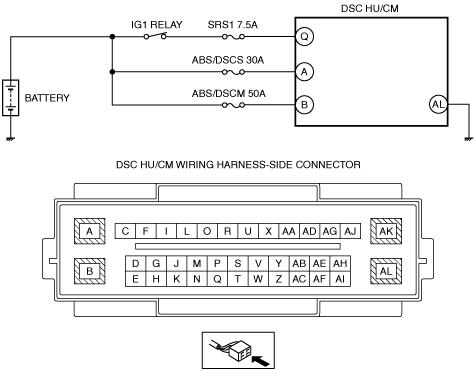DTC
U3003:08, U3003:16, U3003:17
Power supply system
DETECTION CONDITION
• U3003:08
-
― While the vehicle is traveling at a speed of 10km/h {6.2 mph} or more, a CAN signal error caused by low power supply voltage is detected.
• U3003:16
-
― Low ignition voltage (7.9—9.6 V) is detected at the voltage monitor of the solenoid valve or motor monitor. (Except engine cranking condition)― Low ignition voltage (6.0—7.9 V) is detected at the voltage monitor of the solenoid valve or motor monitor.― Low ignition voltage (below 6.0 V) is detected at the voltage monitor of the solenoid valve or motor monitor.
• U3003:17
-
― High ignition voltage (17 V or more) is detected at the voltage monitor of the solenoid valve or motor monitor.
FAIL-SAFE FUNCTION
• U3003:08
-
― Permits the control and does not illuminate each warning/indicator light.
• U3003:16
-
― Illuminates the ABS warning light, TCS/DSC indicator light, Mazda Radar Cruise Control (MRCC) warning light*1, and Smart Brake Support/Smart City Brake Support (SBS/SCBS) indicator light (amber)*1.― Does not illuminate the brake warning light.*2― Illuminates the brake warning light.*3*4― Tire pressure monitoring system warning light*1 illuminates after flashes.― Inhibits the ABS, TCS, DSC, brake assist control, vehicle roll prevention function*1, Hill Launch Assist (HLA), TPMS*1, Secondary Collision Reduction (SCR)*1, Mazda Radar Cruise Control (MRCC)*1, Smart Brake Support (SBS)*1, and Smart City Brake Support (SCBS)*1 controls.― Permits the EBD control.*2― Inhibits the EBD control.*3*4
• U3003:17
-
― Illuminates the ABS warning light, brake system warning light, TCS/DSC indicator light, Mazda Radar Cruise Control (MRCC) warning light*1, and Smart Brake Support/Smart City Brake Support (SBS/SCBS) indicator light (amber)*1.― Tire pressure monitoring system warning light*1 illuminates after flashes.― Inhibits the ABS, EBD, TCS, DSC, brake assist control, vehicle roll prevention function*1, Hill Launch Assist (HLA), TPMS*1, Secondary Collision Reduction (SCR)*1, Mazda Radar Cruise Control (MRCC)*1, Smart Brake Support (SBS)*1, and Smart City Brake Support (SCBS)*1, controls.
*1: If equipped.
*2: When power supply voltage is 7.9—9.6 V for 700 ms or more.
*3: When power supply voltage is 6.0—7.9 V for 780 ms or more.
*4: When power supply voltage is below 6 V for 50 ms or more.
POSSIBLE CAUSE
• Battery deterioration
• Generator malfunction
• Fuse (SRS1 7.5A, ABS/DSCS 30A, ABS/DSCM 50A) malfunction
• Open or short circuit in wiring harness between DSC HU/CM terminal A and battery
• Open or short circuit in wiring harness between DSC HU/CM terminal B and battery
• Open or short circuit in wiring harness between DSC HU/CM terminal Q and battery
• Open circuit in wiring harness between DSC HU/CM terminal AL and body ground
• Poor connection at connectors (female terminal)
